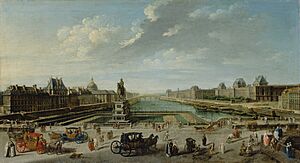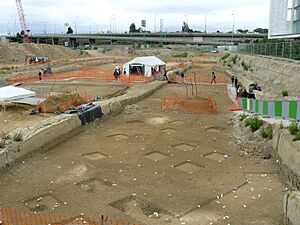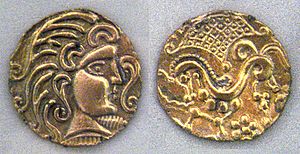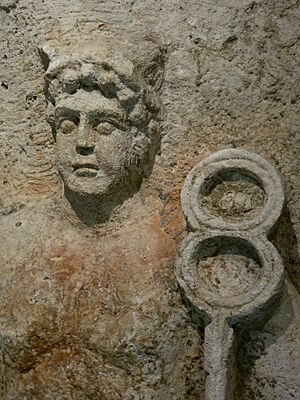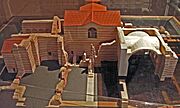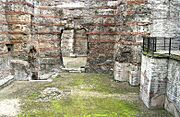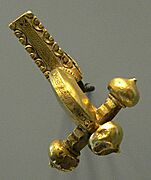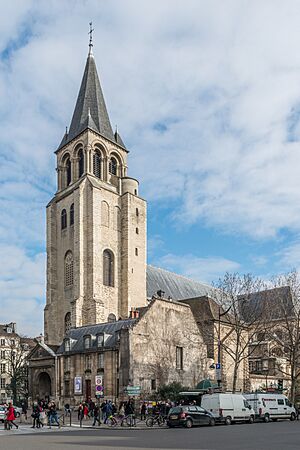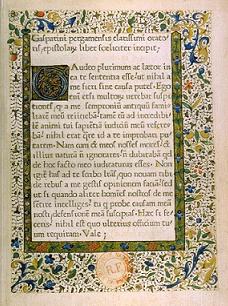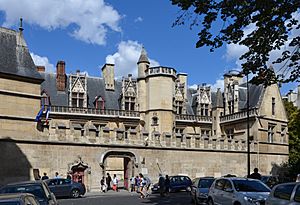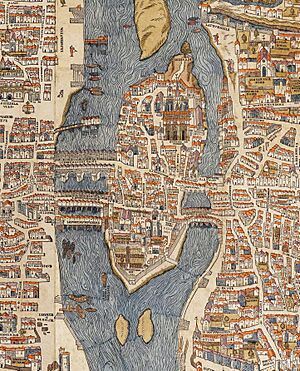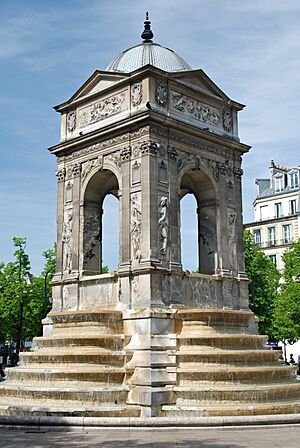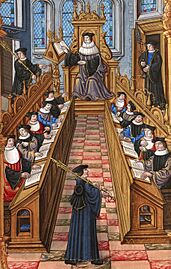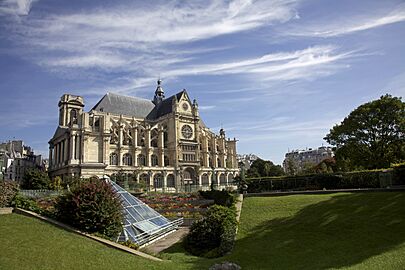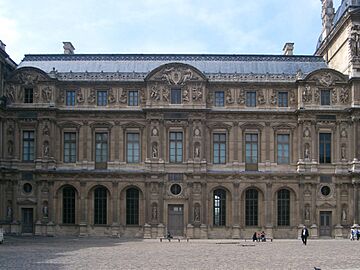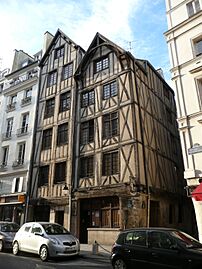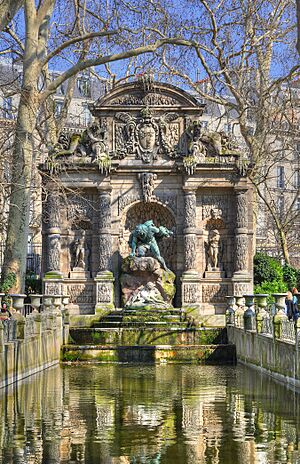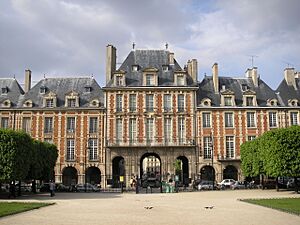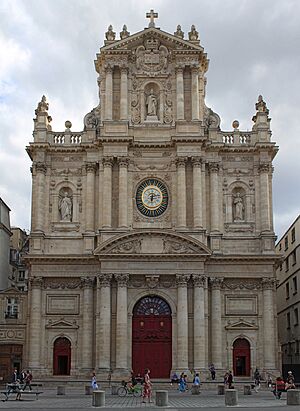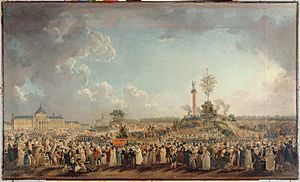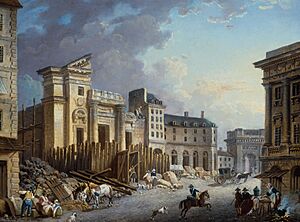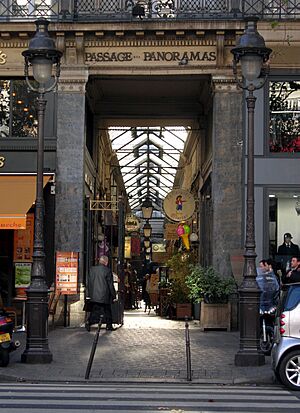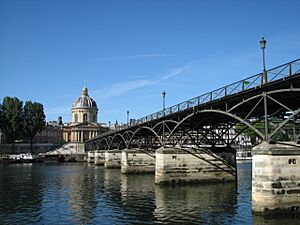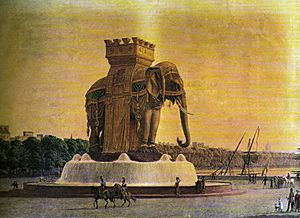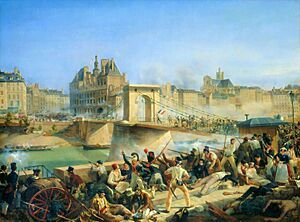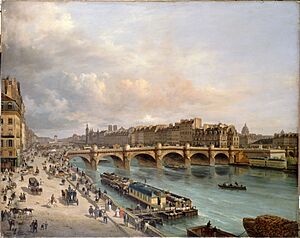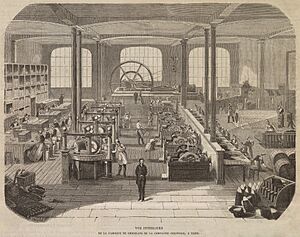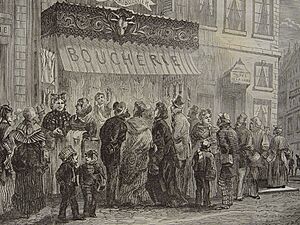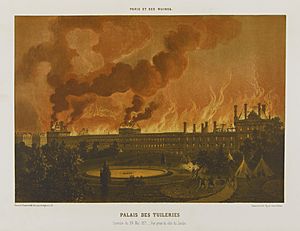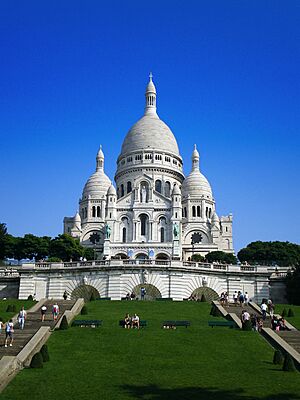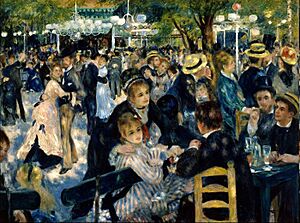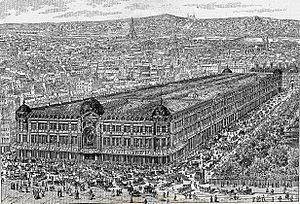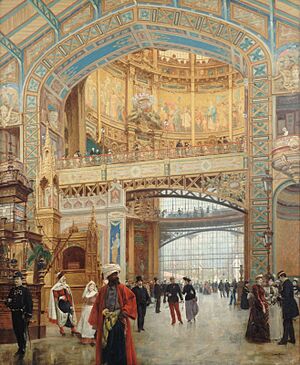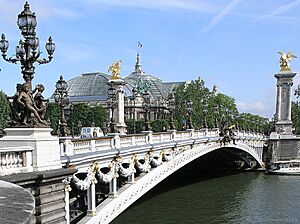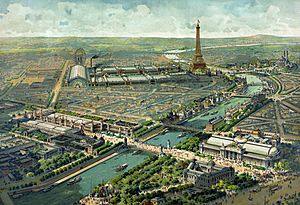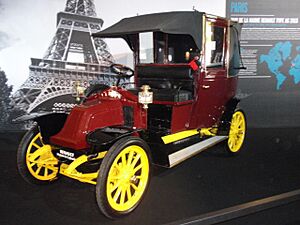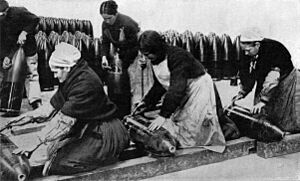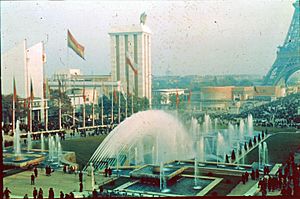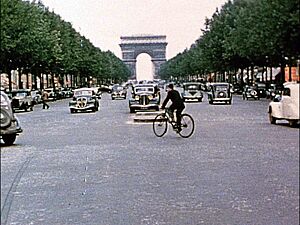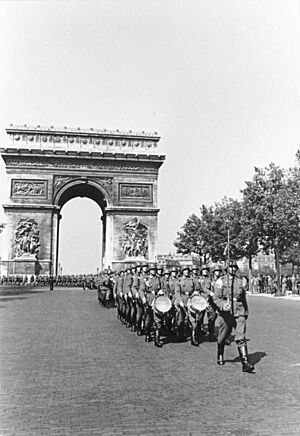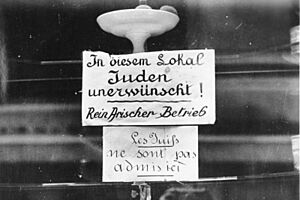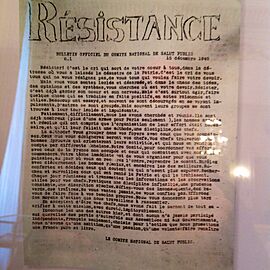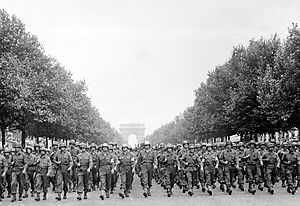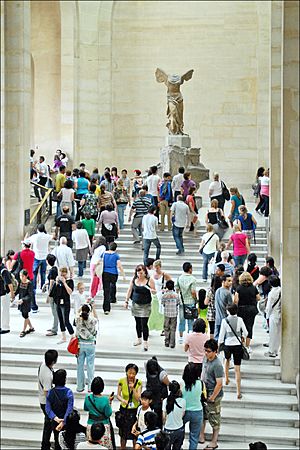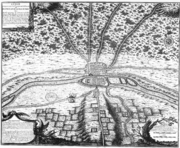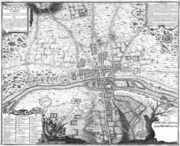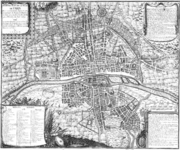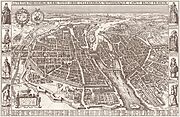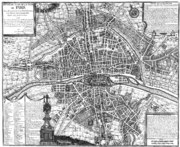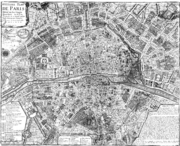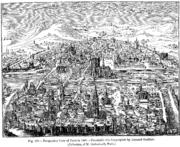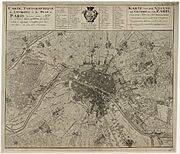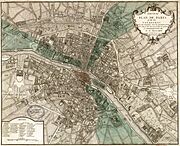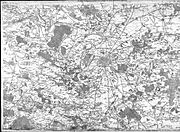History of Paris facts for kids
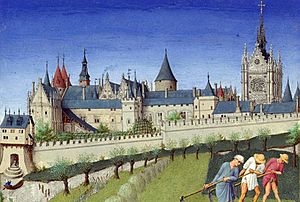
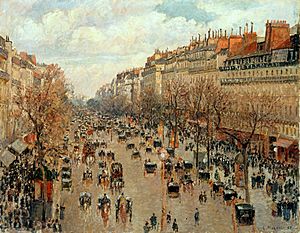
Roman Republic 52–27 BC
Roman Empire 27 BC–AD 395
Western Roman Empire 395–476
Kingdom of Soissons 476–486
Francia 486–843
West Francia 843–987
![]() Kingdom of France 987–1792
Kingdom of France 987–1792
![]() French First Republic 1792–1804
French First Republic 1792–1804
![]() First French Empire 1804–1814
First French Empire 1804–1814
![]() Kingdom of France 1814–1815
Kingdom of France 1814–1815
![]() First French Empire 1815
First French Empire 1815
![]() Kingdom of France 1815–1830
Kingdom of France 1815–1830
![]() July Monarchy 1830–1848
July Monarchy 1830–1848
![]() French Second Republic 1848–1852
French Second Republic 1848–1852
![]() Second French Empire 1852–1870
Second French Empire 1852–1870
![]() French Third Republic 1870–1871
French Third Republic 1870–1871
![]() Paris Commune 1871
Paris Commune 1871
![]() French Third Republic 1871-1940
French Third Republic 1871-1940
![]() Military Administration in France 1940–1944
Military Administration in France 1940–1944
∟ part of German-occupied Europe from 1940 to 1944
![]() Provisional Government of the French Republic 1944–1946
Provisional Government of the French Republic 1944–1946
![]() French Fourth Republic 1946–1958
French Fourth Republic 1946–1958
![]() French Fifth Republic 1958–present
French Fifth Republic 1958–present
The city of Paris has a very long and exciting history. The earliest signs of people living here date back about 10,000 years ago. These were hunter-gatherers during the Mesolithic period.
Later, a Celtic tribe called the Parisii settled by the Seine River. They built bridges, a fort, and traded with others. In 52 BC, the Roman army took over and built a town called Lutetia. This town later became Christian. After the Roman Empire fell, Clovis I, King of the Franks, made it his capital in 508 AD.
During the Middle Ages, Paris grew into Europe's largest city. It was a major religious and trading hub. The University of Paris, founded in the 1200s, was one of the first in Europe. The city faced tough times with the Bubonic Plague and the Hundred Years' War.
In the 19th century, Napoleon added grand monuments to Paris. The city became a fashion capital and saw more revolutions. Under Napoleon III, Paris was rebuilt with wide avenues, parks, and new buildings. Millions of tourists came to see the Eiffel Tower.
The 20th century brought challenges like World War I bombings and German occupation in World War II. But Paris also became a global center for modern art. New museums like the Centre Pompidou and Musée d'Orsay opened. The Louvre got its famous glass pyramid.
In the 21st century, Paris continues to add new museums and concert halls. It remains a vibrant city, welcoming young people and immigrants.
Contents
- Ancient Paris: From Stone Age to Roman Rule
- Roman Lutetia: A New City Emerges
- Paris in the Middle Ages (6th–15th Centuries)
- Renaissance and Religious Conflicts (16th Century)
- Paris in the Age of Kings (17th–18th Centuries)
- The French Revolution (1789–1799)
- Napoleon's Paris (1800–1815)
- Paris in the 19th Century: Revolutions and Transformations (1815–1870)
- The Belle Époque (1871–1914)
- Paris in the 20th Century: Wars and Renewal (1914–2000)
- Paris in the 21st Century
- Maps showing Paris's Growth (508 to 1750)
- See also
Ancient Paris: From Stone Age to Roman Rule
Early Settlers: Prehistory in Paris
In 2008, archaeologists found the oldest human remains in Paris. They discovered traces of a hunter-gatherer camp from about 8000 BC. This was during the Mesolithic period, or Middle Stone Age.
Other ancient settlements were found in Bercy in 1991. These dated back to 4500–4200 BC. They found parts of three wooden canoes used by fishermen. These are now at the Carnavalet Museum. Later finds showed people lived here during the Stone Age, Bronze Age, and Iron Age. People in early Paris traded with others across Europe.
The Parisii Tribe and Roman Conquest
Between 250 and 225 BC, the Parisii tribe settled by the Seine River. They were a Celtic group. They built a walled fort, possibly on the Île de la Cité. This island was important for trade routes.
The settlement was called "Lucotocia" or "Leucotecia." It was a good place for trade between Britain and the Roman areas. The Parisii even made their own gold coins.
In 52 BC, Julius Caesar and his Roman army came to Gaul. The Parisii joined other tribes to fight the Romans. The Parisii commander, Camulogene, burned bridges to stop the Romans. But the Romans, led by Titus Labienus, tricked them. In the Battle of Lutetia, the Romans defeated the Parisii. Camulogene was killed.
Roman Lutetia: A New City Emerges
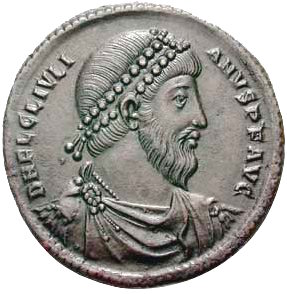
After their victory, the Romans built a new city called Lutetia (or "Lutetia Parisiorum"). It was mostly on the Left Bank of the Seine. The city had Roman streets, a forum, and a large amphitheater. This amphitheater could hold thousands of people.
An aqueduct brought fresh water to the city. It also supplied water to the famous Roman baths, the Thermes de Cluny. Lutetia became a Romanized town.
Christianity arrived in Paris around 250 AD. Saint Denis, the first bishop, was executed for his faith. The hill where he died became Montmartre. By the 4th century, Paris had its first bishop and a cathedral.
Later, Germanic tribes invaded. Many people moved to the safety of the Île de la Cité. They used stones from old buildings to build a wall around the island. The city's name changed from Lutetia to "Parisius," and then simply "Paris."
From 355 to 360 AD, Julian ruled Paris. He was a Roman governor who became Emperor. For a short time, Paris was the capital of the western Roman Empire.
In 451 AD, Attila the Hun threatened Paris. But Saint Geneviève convinced the Parisians to stay and resist. Attila bypassed the city. She later saved the city again during a siege. Saint Geneviève became the patron saint of Paris.
The Franks, a Germanic tribe, grew powerful. In 481, Clovis I became their ruler. He defeated the last Roman armies and entered Paris. He converted to Christianity and made Paris a symbolic capital.
Paris in the Middle Ages (6th–15th Centuries)
From Frankish Kings to Capetians
Clovis I and his family, the Merovingian dynasty, built many churches in Paris. These included a basilica on Montagne Sainte-Geneviève and the first cathedral of Saint-Étienne. They also built monasteries like the Abbey of Saint-Germain-des-Prés. The Basilica of Saint-Denis became the burial place for French kings.
Later, the Carolingian dynasty moved the capital away from Paris. In the 9th century, Vikings repeatedly attacked Paris. They sailed up the Seine River. But the city, protected by the river and walls, held strong. Two stone fortresses, the Grand Châtelet and "Petit Châtelet," defended the bridges.
Around 987, the new Capetian kings came to power. They brought prosperity back to Paris. They rebuilt the royal palace on the Île de la Cité.
Growth of Medieval Paris
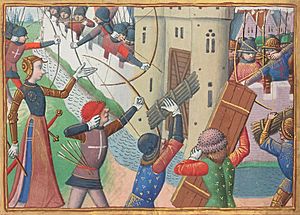
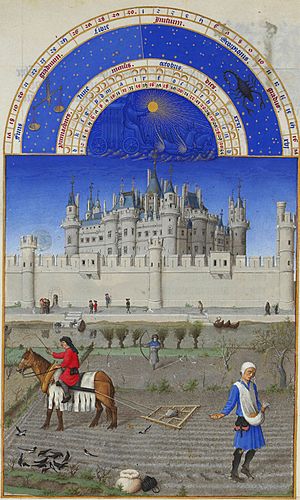
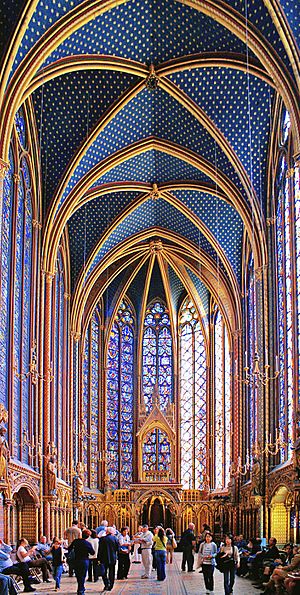
In the 12th century, French kings focused on making Paris a strong capital. The Île de la Cité held the royal palace. Construction of the new Notre-Dame Cathedral began in 1163.
The Left Bank became home to the new University of Paris. The Right Bank grew as a center for trade and business. A group of merchants, the Hanse parisienne, became very powerful.
King Philip II built the huge Louvre fortress to protect the city. He also built new stone walls around Paris. He paved the muddy streets with stone and rebuilt bridges. He started building Les Halles, a central market.
King Philip IV (1285-1314) made the royal residence on the Île de la Cité into a grand palace. King Charles V (1356-1383) built new city walls and the Bastille fortress.
Gothic Architecture and the University
A new style of church building, called Gothic, began in Paris. Suger, the abbot of Saint-Denis, rebuilt the Basilica of Saint Denis with large stained glass windows. This style spread quickly.
The Notre-Dame Cathedral was another huge Gothic project. It was 125 meters long and had towers 63 meters high. King Louis IX (1226–1270) built the beautiful Sainte-Chapelle to hold holy relics. It has some of the oldest stained glass windows in Paris.
The University of Paris became a major learning center. Students came from all over Europe. They studied in Latin, so the Left Bank became known as the Latin Quarter. The famous Sorbonne college opened in 1257.
Challenges: Plague and War
In the 14th century, Paris faced terrible times. The Bubonic plague killed many people. The Hundred Years' War also brought hardship. English armies attacked the countryside.
From 1418 to 1436, the city was occupied by English soldiers. Joan of Arc tried to free Paris in 1429 but was wounded. When the English left in 1436, Paris was in ruins. Many people had left.
After the wars, French kings often lived in the Loire Valley. King Francis I finally moved the royal residence back to Paris in 1528.
Renaissance and Religious Conflicts (16th Century)
By 1500, Paris was thriving again, with a population of 250,000. New kings added buildings and fountains in the new Renaissance style from Italy.
King Louis XII rebuilt the Pont Notre-Dame in stone. It had 68 houses and shops on it. King Francis I started building the first Hôtel de Ville (city hall) in 1533. He also made the Louvre his home and added a new Renaissance wing. Paris became a major center for book publishing.
Francis I created a new part of the University of Paris to teach Hebrew, Greek, and mathematics. This became the Collège de France.
His son, Henry II, continued to decorate Paris in the Renaissance style. He added a new wing to the Louvre. His wife, Catherine de' Medici, built the Tuileries Palace and the Jardin des Tuileries (Tuileries Garden).
However, religious tensions grew between Catholics and Protestants. This led to the French Wars of Religion. On August 24, 1572, thousands of Protestants were killed in the St. Bartholomew's Day massacre.
King Henry IV eventually converted to Catholicism and entered Paris in 1594.
-
A meeting at the University of Paris in the 16th century.
-
The Lescot wing of the Louvre, rebuilt by Francois I.
Paris in the Age of Kings (17th–18th Centuries)
Rebuilding and Royal Grandeur
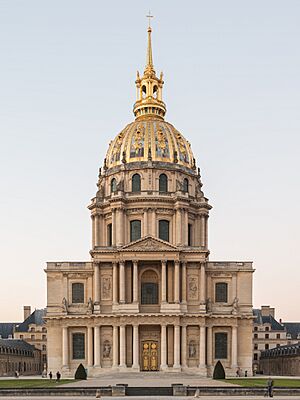
After the religious wars, Paris was damaged. King Henry IV worked to rebuild it. He finished the Pont Neuf, the first Paris bridge without houses. He also built the "Place Royale" (now Place des Vosges), a beautiful new square.
Henry IV's wife, Marie de' Medici, built the Luxembourg Palace and the Medici Fountain. She also rebuilt an old Roman aqueduct to bring water to her gardens.
King Louis XIII continued work on the Louvre. His minister, Cardinal de Richelieu, built a grand new residence, the "Palais-Cardinal" (now Palais-Royal). New churches in a Roman-inspired style were built, like Saint-Paul-Saint-Louis.
Paris's population grew to 400,000. New bridges were built, and wealthy people built elegant homes called hôtels particuliers. Paris became a cultural center. The Académie Française was created in 1635. The first public garden, the Jardin des plantes, opened in 1633.
Louis XIV and the Move to Versailles
When Louis XIV became king, he distrusted Paris after a rebellion called the Fronde. He moved the royal residence to Versailles in 1671.
Despite this, Paris continued to grow. Louis XIV wanted to make Paris like ancient Rome. He finished the Louvre's main courtyard and built grand columns. He also built the Collège des Quatre-Nations and Les Invalides, a hospital for soldiers.
Louis XIV tore down the city walls, creating space for the Grands Boulevards. He built two arches, the Porte Saint-Denis and Porte Saint-Martin, to celebrate. The first café-restaurant, the Café Procope, opened in 1686.
The Enlightenment and Revolution's Dawn
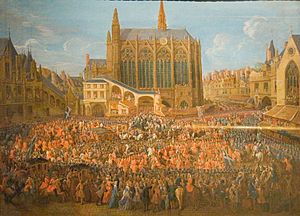
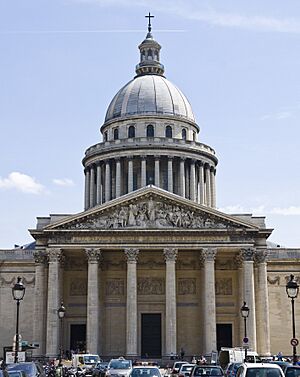
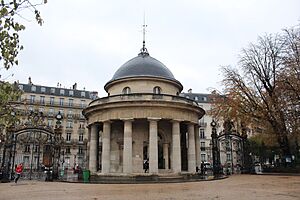
After Louis XIV, the royal court returned to Paris for a few years. But then King Louis XV moved it back to Versailles.
Louis XV and Louis XVI built new public buildings in Paris, like the Panthéon church and the École Militaire (military school). The city expanded westward. The Champs-Élysées boulevard was created, leading to the Place de la Concorde.
Paris grew to 600,000 people by 1789. It was crowded, with narrow, dirty streets. But it was also the center of the Age of Enlightenment. Thinkers like Denis Diderot and Voltaire met in cafés to share ideas. Paris was a hub for publishing, fashion, and luxury goods.
New, elegant neighborhoods like the Faubourg Saint-Germain became popular. Many grand private mansions were built there.
To raise money, King Louis XVI built a new wall around Paris. This wall had gates where taxes were collected on goods entering the city. This tax was very unpopular and added to the growing anger that led to the French Revolution.
The French Revolution (1789–1799)
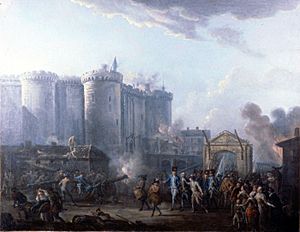
In the summer of 1789, Paris became the heart of the French Revolution. The city had many poor and unemployed people. On July 14, 1789, a crowd stormed the Bastille prison, a symbol of royal power. This event marked the start of the Revolution.
A new city council, the Paris Commune, was formed. Jean Sylvain Bailly became the first mayor. King Louis XVI and his family were brought back to Paris and became virtual prisoners. The new government, the National Assembly, met in Paris.
Hostility grew between those who wanted a king with limited power and those who wanted a republic. On August 10, 1792, a mob attacked the Tuileries Palace. The king's guards were killed. The monarchy was abolished, and France became a republic.
The new government began the Reign of Terror. Louis XVI and Marie Antoinette were executed by guillotine in the Place de la Concorde. Thousands of others were also executed. Churches were closed or destroyed. Many street names were changed.
Eventually, the Reign of Terror ended. A new government, the Directory, took over. In 1799, Napoléon Bonaparte took power in a coup d'état. This ended the Revolution.
Despite the chaos, some building continued. The Pont de la Concorde bridge was finished. The Panthéon became a mausoleum for famous French people. The Louvre became a museum. The first covered shopping streets, like the Passage des Panoramas, opened.
Napoleon's Paris (1800–1815)
After taking power, First Consul Napoleon Bonaparte brought order back to Paris. He made peace with the Catholic church. He also replaced the elected mayor with a Prefect appointed by him.
After becoming Emperor in 1804, Napoleon began grand projects to make Paris an imperial capital. He started building the Rue de Rivoli. He built the Pont des Arts, Paris's first iron bridge. He also named two new bridges after his victories: the Pont d'Austerlitz and the Pont d'Iéna.
In 1806, Napoleon ordered monuments to celebrate France's military glory. The most famous is the Arc de Triomphe. He also built the smaller Arc de Triomphe du Carrousel and the Vendôme Column. He turned an unfinished church, the Madeleine, into a military shrine.
Napoleon also improved the city's infrastructure. He built the Canal de l'Ourcq to bring fresh water to Paris. He also started the Canal Saint-Martin for river transport. His last project was a giant bronze elephant fountain for the Place de la Bastille, but it was never finished.
Paris in the 19th Century: Revolutions and Transformations (1815–1870)
Restoration and Growth
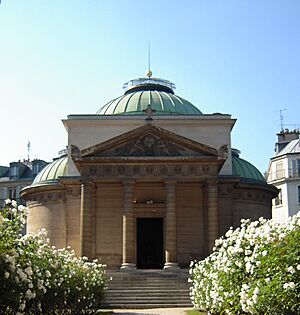
After Napoleon's defeat in 1815, Louis XVIII returned to Paris. The city's cultural life quickly resumed. The Louvre museum was expanded. New churches were built to replace those destroyed during the Revolution. The Chapelle expiatoire was built for Louis XVI and Marie-Antoinette.
Paris grew rapidly, reaching 800,000 people by 1830. The city built the world's first mass public transit system with horse-drawn omnibuses. Street names were put on blue metal plates, a style still used today.
In 1830, a revolution broke out against King Charles X. After three days of fighting, the army joined the people. Charles X left, and Louis-Philippe became the new constitutional monarch.
Louis-Philippe and City Improvements
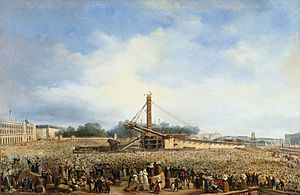
Under King Louis-Philippe, Paris's population grew to over a million. The city center was crowded and unhealthy. The Comte de Rambuteau, the city's prefect, tried to improve it. He paved the Seine's quays and started building Les Halles, the central market.
Louis-Philippe finished the Place de la Concorde in 1836, adding fountains and statues. He also completed the Arc de Triomphe, started by Napoleon. In 1840, Napoleon's ashes were returned to Paris and placed in Les Invalides.
The first railway stations were built in Paris during this time. However, discontent grew among workers. In 1848, another uprising forced Louis-Philippe to leave the throne.
Napoleon III and Haussmann's Transformation

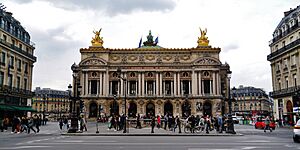
In 1848, Louis-Napoleon Bonaparte became France's first elected President. In 1852, he became Emperor Napoleon III. Paris had a million people, many living in poor conditions.
In 1853, Napoleon III launched a huge project to rebuild Paris. His Prefect, Georges-Eugène Haussmann, led this work. They expanded the city limits and demolished old neighborhoods. They built wide boulevards to connect railway stations and monuments. New buildings along these boulevards had to be the same height and style. This gave central Paris its unique look.
Napoleon III also created four large new parks around the city: the Bois de Boulogne, Bois de Vincennes, Parc des Buttes-Chaumont, and Parc Montsouris. He rebuilt major railway stations and improved the city's sanitation with new sewers and water pipes. Tens of thousands of gaslights were installed. They also built the grand Palais Garnier for the Paris Opera.
Haussmann's projects were massive and caused inconvenience. In 1870, Napoleon III was forced to dismiss him. Soon after, France lost the Franco-Prussian War, and Napoleon III was captured.
Paris's Economy in the 19th Century
Industries grew in Paris during Napoleon's rule. Factories for textiles, sugar, iron, and chemicals appeared. Most Parisians worked in small workshops making luxury goods like clothing, watches, and furniture.
Paris became a major international financial center, second only to London. Banks like Rothschild Frères helped fund France's growth. The Paris Bourse (stock exchange) became a key market.
The Siege and the Commune (1870–1871)
After Napoleon III's defeat in 1870, the Prussian army besieged Paris. The city suffered from cold and hunger. Paris surrendered in January 1871.
A revolt then broke out in Paris, leading to the Paris Commune. This new city council, led by radical socialists, took power. They tried to create a new social program. But the French army soon reconquered the city in fierce fighting. Many Communards were killed or imprisoned. During the fighting, the Communards set fire to several government buildings, including the Tuileries Palace.
The Belle Époque (1871–1914)
After the Commune, Paris was closely watched by the national government. The Basilica of Sacré-Cœur was built on Montmartre. The Hôtel de Ville was rebuilt in a grand style. The ruins of the Tuileries Palace were torn down.
Modern Transport and Art
Paris began to modernize its transport. The first metro line opened in 1900, just in time for the Universal Exposition. Two new bridges were built over the Seine: the Pont Alexandre III and the Pont Mirabeau.
Paris became the birthplace of modern art. Many famous artists lived and worked in Montmartre, including Auguste Renoir and Pablo Picasso. In 1895, the first public movie projection took place in Paris. New art movements like Fauvism began here.
Shopping and World's Fairs
Paris became famous for its grand department stores like Le Bon Marché. These stores offered many goods, fixed prices, and entertainment. They changed how people shopped.
Paris hosted five major international expositions. These events attracted millions of visitors and showed off new technology and trade.
- The 1855 Exposition showcased French industry.
- The 1867 Exposition featured new inventions.
- The 1878 Exposition displayed the telephone and phonograph. The head of the Statue of Liberty was shown here.
- The 1889 Exposition celebrated the French Revolution's 100th anniversary. The Eiffel Tower was built as its gateway.
- The 1900 Exposition celebrated the new century. It featured the world's largest ferris wheel and the first escalator. The Grand Palais and Petit Palais were built for this event.
Paris in the 20th Century: Wars and Renewal (1914–2000)
World War I (1914–1918)
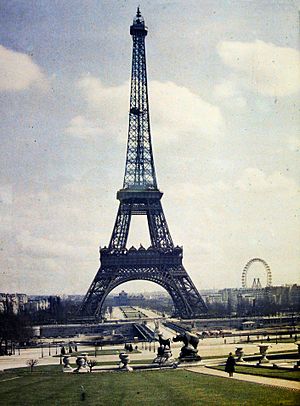
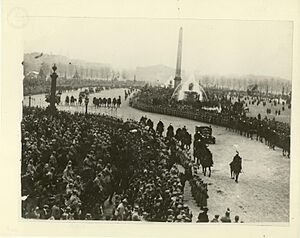
When World War I began in 1914, German armies quickly approached Paris. The French government moved away. In a famous event, about 600 Paris taxis carried soldiers to the front lines. This helped push the Germans back.
Paris was bombed by German planes and long-range guns. Life was hard, with strict rationing of food and coal. Many women worked in factories to produce war supplies. After the war ended in 1918, huge crowds celebrated in the streets.
Between the Wars (1919–1939)
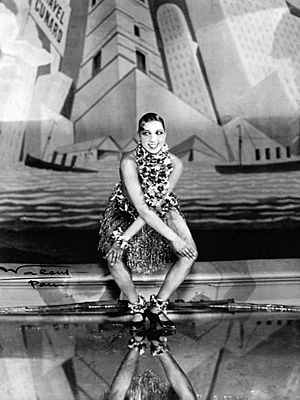
After the war, Paris faced unemployment and high prices. The old city fortifications were torn down and replaced with public housing.
Paris became the capital of the arts during the "crazy years" (les années folles). Artists and writers from around the world came to live and work in Montparnasse. New art movements like Dadaism and Surrealism were born here. George Gershwin composed An American in Paris in the city.
The Great Depression hit Paris in the 1930s. The city's population declined slightly. Political tensions grew between different groups. In 1937, Paris hosted another world's fair. The pavilions of the Soviet Union and Germany faced each other, showing the growing international rivalries.
Occupied Paris and Liberation (1940–1945)

In May 1940, Germany invaded France. The French government fled Paris. On June 14, German soldiers entered Paris. The city was occupied until 1944.
During the Occupation, life was very difficult. There was a curfew, and food and other supplies were rationed. Jews were forced to wear a yellow star and faced severe restrictions. In 1942, thousands of Jews were rounded up by French police and sent to concentration camps.
The Resistance groups formed to fight the occupation. They wrote slogans, published underground newspapers, and attacked German soldiers.
In August 1944, the Allies advanced toward Paris. The Resistance organized an uprising. On August 25, French and American troops entered the city. The German commander ignored Hitler's order to destroy Paris and surrendered. General Charles de Gaulle led a huge parade to celebrate the city's liberation.
Post-War Paris (1946–2000)
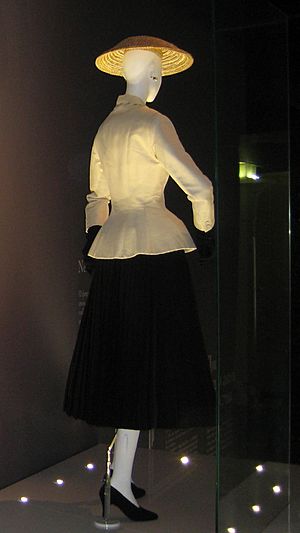
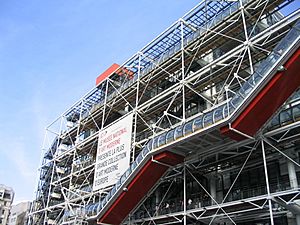
After World War II, Paris was worn down. Rationing continued for several years. Housing was old, and many apartments lacked bathrooms. The government began building new, affordable apartment blocks on the city's edges.
The population of Paris grew again, with many immigrants arriving. However, many middle-class Parisians moved to the suburbs.
Paris's politics were sometimes turbulent. Student uprisings happened in May 1968. But the city's cultural life thrived. New museums opened, and Paris became a fashion capital again with designers like Christian Dior.
Paris had not had an elected mayor since the French Revolution. In 1977, Jacques Chirac became the first elected mayor. He served for 18 years.
French presidents started "Great Works" projects to improve Paris.
- President Charles de Gaulle cleaned the facades of famous buildings like Notre Dame.
- President Georges Pompidou built the Centre Georges Pompidou, a modern art museum with its pipes on the outside.
- President Valéry Giscard d'Estaing turned the old Gare d'Orsay railway station into the Musée d'Orsay art museum.
- President François Mitterrand completed many projects, including the new Bibliothèque nationale de France (national library), the Opéra Bastille (new opera house), and the Louvre Pyramid at the Louvre Museum.
In the post-war era, Paris's suburbs grew a lot. A new subway network, the RER, was built to connect the city to distant suburbs. A ring road, the Périphérique, was completed around the city.
However, some suburbs faced problems as factories closed. These areas, often home to immigrants, had high unemployment. This led to economic differences and sometimes clashes with police.
Paris in the 21st Century
Economy and Tourism
In the 21st century, Paris remains a major financial and global city. Its region has a very high economic output. Many large international companies have their headquarters here.
Tourism is a huge part of Paris's economy. Millions of tourists visit each year, especially from the United States, Europe, China, and the Middle East. Paris is also a world leader in fashion and luxury goods, with famous brands like Louis Vuitton and L'Oréal.
Studies show Paris is one of the most economically powerful cities in the world. It ranks high for quality of life, culture, and research.
Politics and City Life
In 2001, Bertrand Delanoë became the first Socialist mayor of Paris. He was also the first openly gay mayor. He and his successor, Anne Hidalgo (the first female mayor, elected in 2014), focused on social issues and the environment.
To reduce car traffic, the city introduced Vélib', a low-cost bicycle rental system. They also increased parking fees and restricted driving. A section of the highway along the Seine was turned into a public park.
Culture and New Landmarks
The Louvre is the most-visited art museum in the world. The Centre Georges Pompidou is a top modern art museum.
New museums have opened, like the Musée du quai Branly (2006) for indigenous art. The Louis Vuitton Foundation opened a new contemporary art museum in 2014. A new symphony hall, the Philharmonie de Paris, opened in 2015.
On April 15, 2019, the roof of Notre-Dame de Paris caught fire. The central spire and roof collapsed, causing severe damage. Efforts to rebuild the cathedral are ongoing.
Maps showing Paris's Growth (508 to 1750)
See also
 In Spanish: Historia de París para niños
In Spanish: Historia de París para niños
- Writers in Paris
- Architecture of Paris
- Demographics of Paris
- History of France
- Grand Paris
- Paris chronology
- History of parks and gardens of Paris
- History of music in Paris
- Timeline of Paris
- Palais de la Cité


